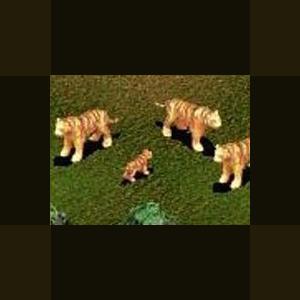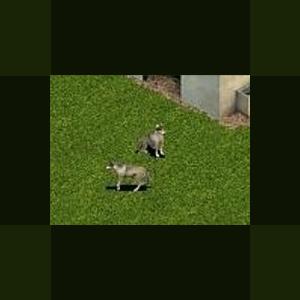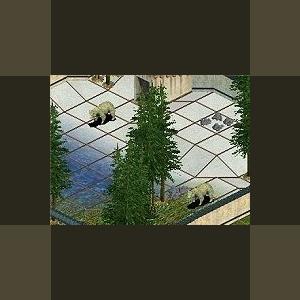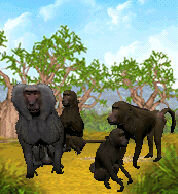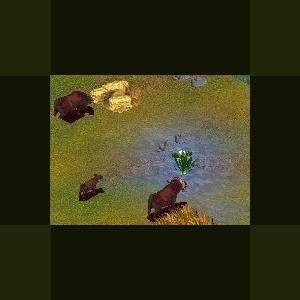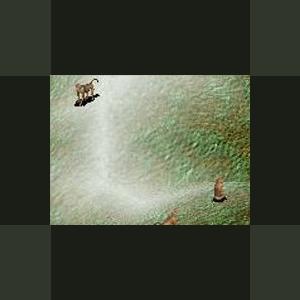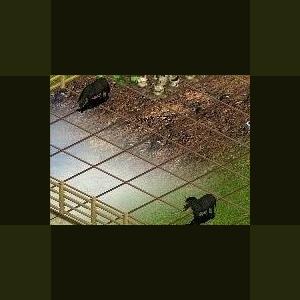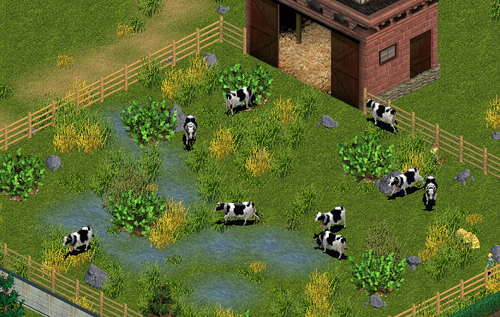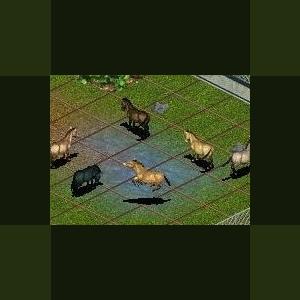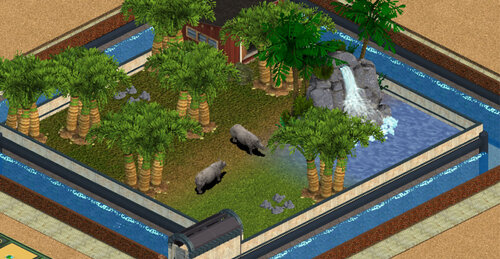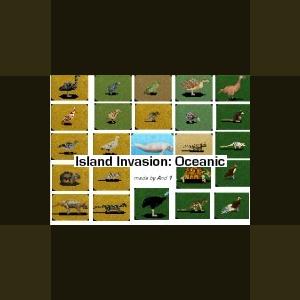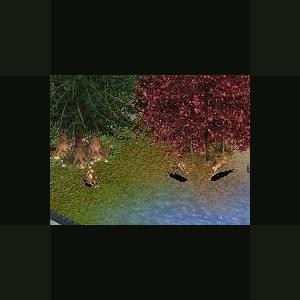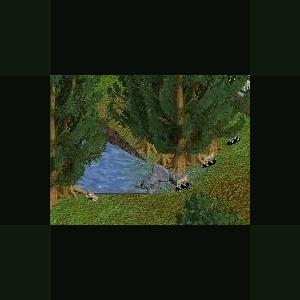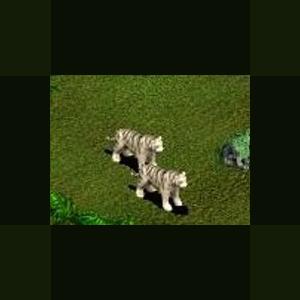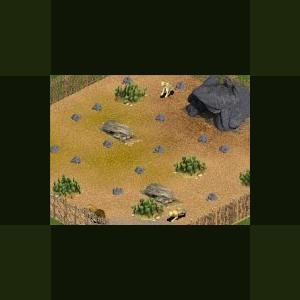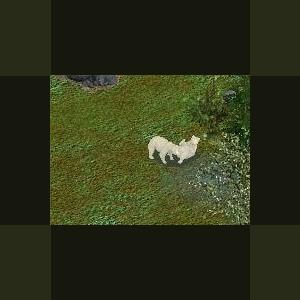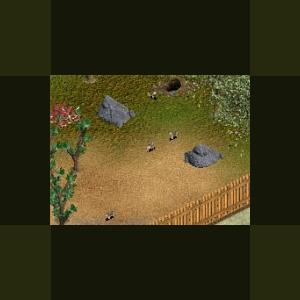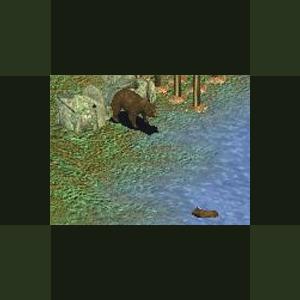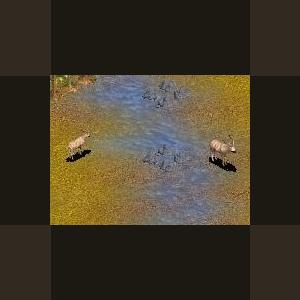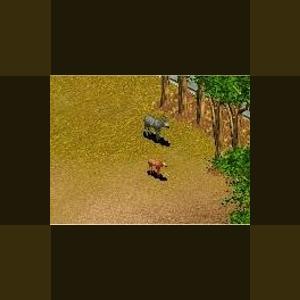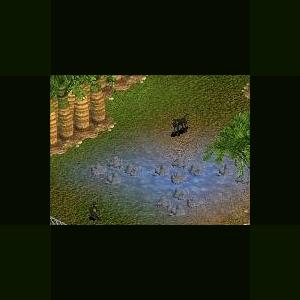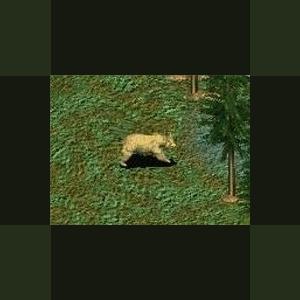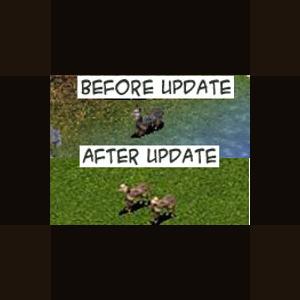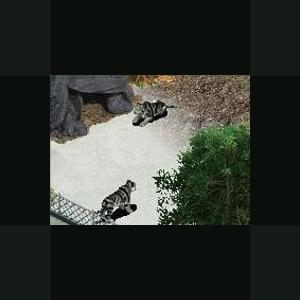279 files
-
Golden Tabby Tiger by Moondawg
By Guest
Golden Tabby Tiger
The Golden Tabby Tiger or Golden Tiger is an extremely rare colour variation caused by a recessive gene and now found only in captive tigers. Like the white tiger it is a colour form and not a separate species. It is sometimes referred to as the strawberry tiger due to the strawberry blonde coloration. No official name has been designated for the color.
The Golden Tabby Tiger or Golden Tiger is an extremely rare colour variation caused by a recessive gene and is currently only found only in captive tigers. Like the white tiger, it is a colour form and not a separate species. In the case of the golden tabby, this is the wide band gene; while the white tiger is due to the color inhibitor (chinchilla) gene. There are currently believed to be less than 30 of these rare tigers in the world, but many more carriers of the gene.
While no official name has been designated for the color, it is sometimes referred to as the strawberry tiger due to the strawberry blonde coloration. he golden tabby's white coat and gold patches make it stand out from the norm. Their striping is much paler than usual and may fade into spots or large prominent patches. Golden tabby tigers also tend to be larger and, due to the effect of the gene on the hair shaft, have softer fur than their orange relatives.
Like their white cousins ,all golden tabby tigers have mainly Bengal parentage, but are genetically polluted with the genes of the Amur tiger via a part-Amur white tiger called Tony, who is a common ancestor of almost all white tigers in North America. The suggestion that this coloration is caused through the deliberate breeding of Amur tigers with Bengal tigers is a popular myth founded on this fact. All golden tabbies appear traceable to one of Tony's male descendents, Bhim.
India has records of wild golden tigers which date back as far as the early 1900s. There have been suggestions that the tendency for this coloration gradually developed in a small group of tigers living in an area of heavy clay concentration. The unusual color would provide these tigers with extra camouflage. The theory remains unproven, however, inbreeding of a small isolated group of tigers could cause the recessive golden tabby gene to emerge if at least one of those tigers carried the recessive gene for the golden color and bred with its own offspring (as has happened in captivity).
Golden tigers and stripeless or nearly stripeless tigers may occur in the same litter. This is due to the effect of the wide band gene on the normal orange colour and the white colour respectively. The wide band mutation is not found solely in white tigers and may also be carried by normal coloured tigers, however carriers of the wide band gene are probably no longer found in the wild. Wild-born golden tabby tigers might be disadvantaged as they are less well camouflaged than normal orange tigers. The last known wild Golden Tabby tigers were shot outside of Mysore Padesh, India in the early 20th century. But there are just under 30 left in captivity.
Few zoos have bred or exhibited golden tabby tigers and many have no knowledge of the color or its mode of inheritance. It therefore usually appears by accident when breeding orange and white tigers together rather than through planning. As white tigers and heterozygous normal coloured tigers are traded and loaned between zoos and circuses for breeding, if they also carry the wide band gene, that gene becomes widespread. When their descendants are mated together, the golden tabby colour is passed on to the offspring if both parents are gene carriers. Unless golden tabby cubs are born, the zoos may have no idea that the parents carry that gene.
The first golden tiger cub born in captivity was in 1983 and this came from standard-colored Bengal tigers, both of whom carried the recessive genes for both the golden tabby and white colours. It was born at Dr. Josip Marcan's Adriatic Animal Attractions in Deland, Florida.
An example of a Golden Tabby is in Dream World in Australia. Samara, a normal orange tigress, had been mated with nearly-stripeless white male, Mohan. Her litter included one normal orange cub (Sultan), the first white tiger born in Australia (Taj, also nearly stripeless), and the first two tabby-colored tigers (male Rama and female Sita) born in Australia. The cubs weighed around 1.5 kilograms and measured approximately 30 centimeters in length. They were removed from their mother soon after birth and hand raised. The births and hand-raising process were filmed and presented in an hour long documentary. Golden tabby Sita will be mated to an unrelated normal orange tiger called Kato.
Diamond, a male golden tiger, is housed at the Isle of Wight Zoo in the UK. Because he is inseparable from his normal coloured sister, who also carries the golden gene, Diamond was castrated to prevent inbreeding. Longleat Safari Park in the UK also has a golden tiger. Glasgow Zoo's golden tiger, Butu (also spelled Bhutto), obtained from Longleat, went to Germany when Glasgow Zoo closed. Longleat previously had an elderly golden tiger named Sonar, but he passed away in 2006.
A few Golden Tabby's are also found at Six Flags Great Adventure in Jackson, New Jersey: A male, Kingda Ka, who has a roller coaster named after him, and a few others who make up the family that appears in daily educational award-winning shows about these specific tigers.
Though golden tabby tigers are not deliberately bred for by conservation-minded zoos, they have joined the white tiger in becoming popular for use in stage shows and similar events. A few private breeders are attempting to produce golden tabby tigers alongside white tigers to meet demand. The golden tabby tiger and the white tiger could therefore be regarded as human-perpetuated "breeds", however, some zoos and wildlife parks refer to both golden tigers and white tigers as endangered.
Litters of different colored cubs are not unusual because the white and golden tabby colours are caused by combinations of hidden recessive genes carried by the parents. White tigers, such as Dreamworld's Mohan (named after the white tiger captured in India in the 1950s), are highly inbred. Inbreeding reduces genetic variability and may cause hidden genes to manifest as there is a greater probability that two recessive genes will meet up.
Analysis of golden tabby tiger family trees shows that golden tabbies are genetically normal orange coloured tigers with the addition of a recessive modifiying gene, probably the wide band gene. This same wide band gene also gives rise to stripeless white tigers. A white tiger that inherits two copies of the recessive wide band gene will be a stripeless white. A normal orange tiger that inherits two copies of the recessive wide band gene will be a golden tabby. The wide band gene is carried independently of the white gene.
All golden tabby tigers seem traceable to a white tiger called Bhim, a white son of Tony. Bhim was a carrier of the wide band gene and transmitted this to some of his offspring. Bhim was bred to his sister Sumita (also a carrier of the wide band gene), giving rise to stripeless white tigers (i.e. having two copies of the wide band gene). Bhim was also bred to a normal orange tigress called Kimanthi, and then to his own orange daughter Indira from that mating. The mating of Bhim and Indira resulted in striped white, stripeless white, normal orange, and golden tabby offspring indicating that both Bhim and his daughter carried the wide band gene. When the golden tabby male offspring was mated to the normal orange female offspring, both golden tabby tigers and white tigers resulted.
At Dreamworld, Australia, it was demonstrated that the mating of a nearly stripeless white tiger to an orange tigress that carried both white and wide band genes would result in golden tabby offspring alongside nearly stripeless white and normal orange cubs.
Updated 2010-11-03
Just to save space with less in zip and smaller image.
Nothing new
404 downloads
0 comments
Updated
-
Great Plains Wolf by Ghirin
By Guest
The Great Plains wolf (Canis lupus nubilus) is a subspecies of gray wolf that used to roam the
central grasslands of North America. This wolf, also known as the buffalo wolf,
was thought to be extinct, but currently the wolves of Michigan, and Minnesota are considered to be
members of the subspecies.
References:
http://www.lioncrush...l.asp?animal=35
http://en.wikipedia....eat_Plains_Wolf
Created by Ghirin 2008
Updated 2010-11-03
Just to save space with less in zip and smaller image.
Nothing new
338 downloads
0 comments
Updated
-
Grolar Bear by Coolperson5
By Guest
Grolar Bear by Coolperson5
The Grolar Bear is a Grizzly-Polar bear hybrid.
Screenshot updated September 13, 2007
Updated 2010-11-03
Just to save space with less in zip and smaller image.
Nothing new
276 downloads
0 comments
Updated
-
Hamadryas Baboon
By Khaydar
Adopt an Hamadryas Baboon (Papio hamadryas) for your Zoos
Hamadryas Baboon description:
Minimum happiness needed for chance of breeding: 95.
Liked foliage:
Acacia Caffra Tree, Savannah foliage
Liked rock:
Large Rock, Small Rock - Medium, Small Rock - Small
Animal can jump.
Animal can climb objects.
Animal can climb cliff.
Number of animals allowed per exhibit: 3-20 with 15 squares each.
A suitable exhibit for 3 of this animal has 45 squares containing terrain of:
22 Savannah Grass, 9 Sand, 5 Dirt, 7 Brown Stone, 2 Fresh Water
using 5 grid squares filled with 4 Acacia Caffra Tree most liked plant
and using 25 Small Rock - Small most liked rock.
Preferred shelter: Large Concrete Shelter.
258 downloads
- khaydars animal
- living animal
- (and 1 more)
Updated
-
Hereford Cow by Genkicoll
By Guest
Made by request, a special surprise for Menolly.
The Hereford breed was founded some two and one-half centuries ago as a product of necessity. Thrifty and enterprising farmers near Hereford in the County of Herefordshire, England, were determined to produce beef for the expanding food market created by Britain's industrial revolution. To succeed in Herefordshire, these early-day cattlemen realized they must have cattle which could efficiently convert their native grass to beef and do it at a profit.
There was no breed in existence at the time to fill that need, so the farmers of Herefordshire founded the beef breed that logically became known as Herefords. These early Hereford breeders molded their cattle with the idea in mind of a high yield of beef and efficiency of production, and so firmly fixed these characteristics that they remain today as outstanding characteristics of the breed.
Beginning in 1742 with a bull calf from the cow Silver and two cows, Pidgeon and Mottle, inherited from his father's estate, Benjamin Tomkins is credited with founding the Hereford breed. This was 18 years before Robert Bakewell began developing his theories of animal breeding. From the start, Mr. Tomkins had as his goals economy in feeding, natural aptitude to grow and gain from grass and grain, rustling ability, hardiness, early maturity and prolificacy, traits that are still of primary importance today.
Other pioneering breeders were to follow the Tomkins' lead and establish the world-wide renown for the Herefordshire cattle causing their exportation from England to wherever grass grows and beef production is possible.
Herefords in the 1700's and early 1800's in England were much larger than today. Many mature Herefords of those days weighed 3,000 pounds or more. Cotmore, a winning show bull and noteworthy sire, weighed 3,900 pounds when shown in 1839. Gradually, the type and conformation changed to less extreme size and weight to get more smoothness, quality and efficiency.
Source: http://www.ansi.okstate.edu/breeds/cattle/hereford/
*NOTE: 100% compatible with the prairie peafowl by Genki and the silkies made by Sundance.
Updated 2010-11-03
Just to save space with less in zip and smaller image.
Nothing new
464 downloads
Updated
-
Highland Rhesus Macaque by Ghirin
By Guest
Highland Rhesus Macaque
Author: Ghirin
Rhesus macaques (Macaca mulatta) are very adaptable primates and have a wide range in southern Asia. They have been reported in habitats ranging from sea level to elevations of 2500 meters, including snow, intense heat, near-desert, dense forests and cities.
They will eat a wide variety of foods, including fruit, vegetation, eggs, small animals, insects, crops and assorted human foodstuffs.
Highland rhesus macaques dwell in the countries of Nepal, China, India, and Pakistan.
Created by Ghirin 2003
Updated 2010-11-03
Just to save space with less in zip and smaller image.
Nothing new
322 downloads
0 comments
Updated
-
Hippidion by Jordan
By Guest
Hippidion (meaning pony) was a horse-related, Clydesdale-sized ungulate that lived in South America during the Pleistocene epoch, between 2 million and 10,000 years ago.
Hippidion was probably a descendant of Merychippus, a genus of horses that migrated into the South American continent around 5 million years ago. It stood about approximately 1.4 meters (4 ft, 6 in.) high at the shoulders and resembled a donkey. Evidence from the delicate structure of the nasal bones in the animal suggests that Hippidion evolved in isolation from the other horse species of North America.
Hippidion and similar South American horses went extinct approximately 8000 years ago, and did not reappear there until the 1500s as a result of introduction by humans.
Created by Jordan for Zoo Tek - 2007
Updated 2010-11-03
Just to save space with less in zip and smaller image.
Nothing new
222 downloads
0 comments
Updated
-
Holstein Friesian Cow by Serpyderpy
By Serpyderpy
Holstein Friesian Cows are one of the highest dairy producing cattle species in the world. They have distinct black and white markings and are a very common sight on farms. Now you can have these wonderful cattle in your zoos!
Graphics extracted from Age of Empires. Sounds taken from Harvest Moon DS. Enjoy!
443 downloads
0 comments
Updated
-
Horse Pack by Jordan
By Guest
Horse Pack by Jordan
Six colors of horses that will live happily together. Includes: bay, black, buckskin, palomino, sorrel and roan horses.
Updated September 8, 2023 by Jay to show the preferred foliage tooltip for the female and young, to correct the behaviors broken by APE, to remove unnecessary files and configuration lines, to add some spacing in the animal info, and to include a combined ztd.
Updated 2010-11-03
Just to save space with less in zip and smaller image.
Nothing new
639 downloads
Updated
-
Indian Rhinoceros
By Khaydar
Adopt an Indian Rhinoceros (Rhinoceros unicornis) for your zoos.
Indian Rhinoceros description:
Minimum happiness needed for chance of breeding: 90.
Liked foliage:
Rainforest Fern, Mangrove Tree, Foxtail Palm Tree
Liked rock:
Large Rock, Small Rock - Medium, Small Rock - Small
Animal can climb cliffs.
Number of animals allowed per exhibit: 1-6 with 50 squares each.
A suitable exhibit for 2 of this animal has 100 squares containing terrain of:
50 Rainforest Floor, 10 Dirt, 20 Grass, 20 Fresh Water
using 9 grid squares filled with 4 Foxtail Palm Tree most liked plant
and using 8 Small Rock - Small most liked rock.
Preferred shelter: Large Stable.
Other liked items:
Waterfall Rock
Credits to Aurora Designs
Made by Khaydar
187 downloads
- rhinoceros
- living animal
- (and 1 more)
0 comments
Updated
-
Island Invasion Oceanic by And 1
By Guest
The Pack contains 24 animals of the Oceanic Area.
File is in english and german.
Animals included:
Sylviornis neocaledoniae (german: Du)
Numbat
Thorny Devil (german: Dornteufel)
Lace Monitor (german: Buntwaran)
Cape Barren Goose (german: Hühnergans)
Malleefowl (german: Thermometerhuhn)
Spinifex Pigeon (german: Rotschopftaube)
Lesser Bird of Paradise (german: Kleiner Paradiesvogel)
Adzebill (german: Aptornis)
King Island Emu (german: Schwarzer Emu)
Matschie's Tree-kangaroo (german: Matschie Baumkänguru)
South Island Goose (german: Südinsel Riesengans)
Common Wombat (german: Nacktnasenwombat)
Little Spotted Kiwi (german: Zwergkiwi)
Tiger Quoll (german: Riesenbeutelmarder)
Northern Cassowary (german: Einlappenkasuar)
Marsupial Lion (german: Beutellöwe)
Black-spotted Cuscus (german: Tüpfelkuskus)
Weka (german: Wekaralle)
Takahe
Quokka
Meiolania (german: Riesen Hornschildkröte)
Dugong
Western Long-beaked Echidna (german: Westlicher Langschnabeligel)
Updated 2010-11-03
Just to save space with less in zip and smaller image.
Nothing new.
2,062 downloads
Updated
-
Japanese Macaque by Coolperson5
By Guest
Japanese Macaque by Coolperson5
The Japanese Macaque is the farthest northern living non-human primate. They are known for being very smart and copying humans.
Updated 2010-11-03
Just to save space with less in zip and smaller image.
Nothing new.
387 downloads
0 comments
Updated
-
Japanese Wolf by Ghirin
By Guest
Japanese Wolf
Author: Ghirin
A correction and update for the original Japanese wolf which was released Aug 8 2003
The Japanese wolf (Canis lupus hodophilax), was the smallest species of gray wolf in the world (about the size of a jackal). It was found on the Japanese islands of Honshu, Hokkaido, Shikoku and Kyushu where it lived in the mountainous areas. Its small stature and short legs were ideal for roaming the mountain forests.
The Japanese wolf was known by several names including shamanu, okami (Great God), magami (True God), and yama no kami (Mountain God). The Ainu people of Japan called it the Howling God because these wolves would howl for hours from hilltops and mountains.
Even though this wolf was small, many legends surrounded it. Many people feared the Howling God and placed charms near their doors to ward it away. Others thought of the wolf as a protector and built shrines to it.
As the human population of Japan increased, the Japanese wolf lost habitat. A bounty was also paid for its skin. The last recorded killing of a wolf was in 1905, though some have reported sightings of an animal resembling the Japanese wolf.
It's interesting that there is Japanese serow in the new animal pack. The wolf and serow would make nice complimentary exhibits in a Japanese-themed area. The Japanese wolf is also very attractive to guests.
Created by Ghirin 2003
Updated 2010-11-03
Just to save space with less in zip and smaller image.
Nothing new.
336 downloads
0 comments
Updated
-
Javan Tiger by Moondawg
By Guest
The Javan tiger (Panthera tigris sondaica) was a tiger limited to the Indonesian island of Java.
It now seems likely that this subspecies was made extinct in the 1980s, as a result of hunting and habitat destruction, but the extinction of this subspecies became increasingly probable from the 1950s onwards, when it is thought that fewer than 25 tigers remained in the wild. The last specimen was sighted in 1972. A track count in 1979 concluded that three of the tigers were in existence. However it is possible that it is not extinct, as in the 1990s, there were some unverified reports of sightings.
By 1940, the Javan tiger had been pushed into remote mountain ranges and forests. Some small reserves were set up, but were not large enough, and the quantity of prey species were too low. By the mid-1950s, 20-25 tigers remained on Java. Half of these were in the well-known Ujong Kulon Wildlife Reserve, but the 1960s saw all tigers eliminated from this area and also from Baluran National Park. By 1972, the Javan tiger count was down to a maximum of seven in the newly-formed Meru Betiri Forest Reserve, and perhaps five elsewhere. Meru Betiri was rugged and considered this tiger's last chance for survival. However, even as it was declared a reserve, the area was under attack by agricultural development. A 1979 census located the tracks of only three tigers. Substantiated evidence that this tiger is still alive has not been forthcoming since then. The exact time of extinction remains unknown, but this was probably sometime in the mid-1980s.
Javan tigers were very small compared to other subspecies. Males were between 100 kg (220 lb) and 141 kg (310 lb) on average and around 2.45 m (8.0 ft) in length. Females weighed between 75 kg (170 lb) and 115 kg (250 lb) on average and are smaller than males in length.
Occasional reports still surface of a few tigers to be found in east Java where the forested areas account for almost thirty percent of the land surface. Meru Betiri National Park, the least accessible area of the island, is located here and considered the most likely area for any remaining Javan tigers. This park is now coming under threat from three gold mining companies after the discovery of 80,000 tons of gold deposit within the locality.
Despite the continuing claims of sightings it is far more likely that, even with full protection and in reserve areas, the Javan tiger was unable to be saved. The 'tigers' are quite likely to be leopards seen from a distance.
At the present time the World Conservation Monitoring Centre lists this subspecies as having an 'outstanding query over status' rather than 'extinct', and some agencies are carrying out experiments using infrared activated remote cameras in an effort to photograph any tigers. Authorities are even prepared to initiate the move of several thousand people should tiger protection require this.
But until concrete evidence can be produced (expert sightings, pug marks, photographic evidence, attacks on people and animals), the Javan tiger must be considered yet another tiger subspecies which is probably extinct.
In November 2008, an unidentified body of a female mountain hiker was found in Mount Merbabu National Park, Central Java, allegedly died from tiger attack. Villagers who discovered the body has also claimed some tiger sightings in the vicinity.
Updated 2010-11-03
Just to save space with less in zip and smaller image.
Nothing new.
401 downloads
0 comments
Updated
-
Kalahari Lion by Coolperson5
By Guest
The lion is the largest African carnivore. The native habitat of the lion is the wide savannah of central and southern Africa. This region's wide swaths of tall grasses provide excellent coverage for lions on the hunt, and the occasional tree provides shade for resting lions. The lion spends over 20 hours a day resting, usually in the shade of trees or rocks. However, the lion is a very athletic cat, capable of impressively long and high leaps. They are also terrific climbers.
Unlike other large cats, lions are social in nature, living in prides of up to 40 animals, primarily females and cubs. Lions hunt both singly and in groups, although their success rate is much higher in groups. The lionesses do most of the hunting, while the male lions protect the pride from predators, including other lions. For every dozen attempts, lions average one kill. Their diet varies by region but may include gazelle, zebra, and wildebeest. In captivity, lions eat a steady diet of meat and dry foods. These large cats require a regular supply of drinking water, although otherwise they do not care for this element.
Lions compete with and sometimes prey on the other carnivores found on the savannah. They will sometimes kill and eat leopards and cheetahs. Lions and hyenas have a particular dislike for one another. Adult male lions will go out of their way to kill hyenas.
When agitated, a lion will emit its legendary roar, which can be heard more than six miles away. Lions tend to get quite upset when there is not enough food available.
Lions reproduce very well in captivity.
Updated 2010-11-03
Just to save space with less in zip and smaller image.
Nothing new.
398 downloads
0 comments
Updated
-
Kermode Bear by Ghirin
By Guest
Kermode Bear
The Kermode bear, also known as the spirit bear, is a rare color phase of the North American black bear. These bears are only found in the temperate coastal rainforests of British Columbia, with most of the population living on Princess Royal Island and Gribbell Island.
Only about one in ten of local bear population is actually the creamy white color of the Spirit bear. The others are the normal colors of the black bear (black, brown, grey, or cinnamon).
Created by Ghirin 2004
Updated 2010-11-03
Just to save space with less in zip and smaller image.
Nothing new.
244 downloads
Updated
-
Kit Fox by Coolperson5
By Guest
A fox from the American southwest.
This fox is compatable with the most recent version of my bobcat.
Updated 2010-11-03
Just to save space with less in zip and smaller image.
Nothing new.
332 downloads
0 comments
Updated
-
Kodiak Bear by Ghirin
By Guest
Kodiak Bear
The Kodiak bear (Ursus arctos middendorffi) is the largest subspecies of brown bear and the second largest carnivore in the world (second only to the polar bear). Mature boars (males) can reach 1500 pounds in weight, while mature females can reach up to 750 pounds. Male shoulder heights have been recorded up to 5 feet with standing heights up to 10 feet.
This unique bear is native only to the islands the Kodiak Archipelago, including Kodiak, Shuyak, and Afognak, and have been isolated from other brown bears for about 12,000 years. The current population is between 2800 to 3000 bears.
Even though they are classified as carnivores, Kodiak bears are actually omnivorous, eating a variety of foods and concentrating on what foods are in season. They eat a number of plant foods such as grasses, sedges, and berries when the the plants are most nutritous. Eggs, nestlings and salmon are also valued as rich sources of nutrition and a source of fat for winter hibernation.
Created by Ghirin 2003
Updated 2010-11-03
Just to save space with less in zip and smaller image.
Nothing new.
447 downloads
0 comments
Updated
-
Lechwe by Jordan
By Guest
The lechwe is an antelope that lives on the floodplains of Africa
Updated 2010-11-03
Just to save space with less in zip and smaller image.
Nothing new.
374 downloads
0 comments
Updated
-
Lesser Kudu by Ghirin
By Guest
Lesser Kudu by Ghirin
The lesser kudu (Tragelaphus imberbis) is large antelope found in East Africa. Males and females are dimorphic. The males have grey-brown coats while females have reddish chestnut coats. They prefer areas of dry forest and thornbush.
References:
www.wikipedia.org
www.ultimateungulate.com
*Inspired by the Zoo Tycoon Brains Trust at the Zoo Tycoon Forums*
Updated 2010-11-03
Just to save space with less in zip and smaller image.
Nothing new.
390 downloads
0 comments
Updated
-
Lion-Tailed Macaque by Jordan
By Guest
The lion-tailed macaque is a rainforest-dwelling monkey from the Western Ghats mountains in India.
Updated 2010-11-03
Just to save space with less in zip and smaller image.
Nothing new.
341 downloads
0 comments
Updated
-
Lowland Anoa
By Khaydar
Adopt a Lowland Anoa (Bubalus depressicornis) for your zoos.
Lowland Anoa description:
Minimum happiness needed for chance of breeding: 90.
Liked foliage:
Rainforest Fern, Mangrove Tree
Liked rock:
Large Rock, Small Rock - Medium, Small Rock - Small
Number of animals allowed per exhibit: 1-4 with 20 squares each.
A suitable exhibit for 2 of this animal has 40 squares containing terrain of:
26 Rainforest Floor, 4 Dirt, 8 Grass, 2 Fresh Water
using 5 grid squares filled with 4 Rainforest Fern most liked plant
and using 3 Small Rock - Small most liked rock.
Preferred shelter: Large Lean-to.
Other liked items:
Waterfall Rock
Credits to the ZTABC team for the model and mesh
Made by Khaydar
139 downloads
- living animal
- bovid
- (and 1 more)
0 comments
Updated
-
MacFarlane Bear by Ghirin
By Guest
MacFarlane Bear by Ghirin
MacFarlane's bear is large cryptid bear from the Canadian Northwest Territories.
This bear is known from a buff-colored pelt and a skull. Both were sent to the Smithsonian Institution in Washington, DC.
The exact nature of MacFarlane's bear is unknown. It may be an extinct species or an aberrant form of brown bear.
Reference:
www.cryptozoology.com
www.wikipedia.co
Updated 2010-11-03
Just to save space with less in zip and smaller image.
Nothing new.
252 downloads
0 comments
Updated
-
Mainland Serow by LAwebTek
By Guest
Mainland Serow
Author: LAwebTek
The mainland or Asiatic serow (Nemorhaedus sumatraensis) ranges from the Himalayas of Nepal, north to Gansu and Anhui in China, and south to the Malay Peninsula and Sumatra. Their long, mule-like ears are narrow, pointed and tasseled, and usually longer than their short, black horns. Mainland serows have short beards, a long, heavy mane and less bushy tails than Japanese and Taiwanese serows. Coat color varies greatly by region, however the mainland serow is typically blackish-gray to reddish-brown.
Length and Shoulder Height
Adult length: 39-71 inches (100-180 cm)
Adult shoulder height: 28-43 inches (70-110 cm)
Weight
56-309 pounds (25-140 kg); mainland serows are much larger and heavier than Japanese and Taiwanese serows.
Life Span
Life span in the wild is unknown; serows live over 10 years in zoos.
Diet
Ungulates cannot manipulate food with their forelimbs, so their lips, teeth and tongues are modified to take food directly from the plant or ground and grind vegetation like a mill. Serows, like all Bovidae, are specialized herbivores called ruminants.
In the wild: Serows are predominantly browsers with selective food habits. They eat herbs, leaves of trees or shrubs, shoots, twigs and grasses.
At the zoo: Herbivore pellets, alfalfa, timothy grass hay and seasonal browse, some fruits and vegetables.
Reproduction
Mating takes place in fall or winter. After a gestation period of 200 to 230 days, a single kid weighing about 8 pounds (3.5 kg) is born during the months of May to September. The kid will reach full size and leave the mother’s territory at 12 months and become sexually mature by 3 years.
Life Cycle
Serows, especially males, are usually solitary but sometimes are found in pairs or family groups of up to seven. Both sexes mark territories by rubbing onto rocks and branches a secretion from their preorbital glands. The territory of a solitary individual may be only three acres (1.2 ha), while that of a family group may be up to 54 acres (22 ha).
Although they are less agile and move less rapidly than gorals, serows are sure-footed, clambering easily along well-defined trails on mountain slopes. They feed at dawn and dusk. During the heat of the day, they take shelter in favorite resting places among rocks, in caves, under overhanging rocks or cliffs, or in dense underbrush, hidden from predators such as bears, tigers and wolves. Their smell, vision and hearing are acute.
Resource Defenders
Serows are resource defenders and reflect the ancestral body plan of all Caprinae. Resource defenders are more primitive, tend to be solitary and territorial, and live in small areas of highly productive and diverse habitats which are easily defended. Fossil Caprinae dating back 35 million years closely resemble serows. During the ice ages, most Caprinae species increased in body and horn size, adapted to more severe climates and land forms, and became grazers, roaming over larger areas in cooperative herds. The more familiar goat antelope, the mountain goat Oreamnos americanus, may have evolved from serow-like ancestors in a glacial environment.
Fascinating Facts
Serows are the most primitive living Caprinae. Their fossils appear in the late Pliocene of 7 to 2 million years ago!
Serows can be aggressive and will attempt to fight off predators, even Asian black bears, with their dagger-like horns!
Serows will swim between the small islands near the Malay Peninsula!
2003 LAwebTek
Updated 2010-11-03
Just to save space with less in zip and smaller image.
Nothing new.
242 downloads
0 comments
Updated
-
Maltese Tiger by Jordan
By Guest
The Maltese Tiger or Blue Tiger (Panthera tigris melitensis) is an extremely rare color morph of tiger that has historically been reported in the Fujian Province of China and has only been sighted on a few occasions.
It is said to have bluish fur with dark gray stripes. The term "Maltese" means "slate gray" and comes from the domestic cat world; it does not refer to Malta as the origin of the blue tigers.
Updated 2010-11-03
Just to save space with less in zip and smaller image.
Nothing new.
493 downloads
0 comments
Updated

